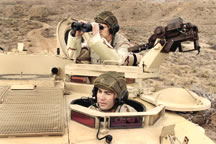Army and Air Force to acquire Sandia Gauntlet body armor for ‘field evaluation’

The Army Rapid Equipment Force and the Air Force Protection Battle Lab are acquiring the Sandia Gauntlet body armor for "field evaluation." The Army will acquire 10 sets of the Sandia arm protection system, and the Air Force will acquire 50 sets. In addition, the Air Force has requested the balance of the Sandia inventory of an early version for training purposes.
Last year Sandia researchers conceived the concept of shoulder-to-hand protective sleeves for military personnel riding atop Humvees and other military vehicles during combat operations. The idea was to protect the entire length of a soldier’s arm, including the hand, from blast and debris effects created by indirect hits from rocket propelled grenades (RPGs) against vehicle doors and turrets. The materials used in the original protective sleeve design were surplus, government-owned Kevlar, and thin, carbon inserts.
A Sandia-wide team was formed to transition the concept to the military. The team was able to balance the need for urgent delivery of protective equipment to soldiers in the field with the need to ensure that the delivered product met minimum standards for protection. The newest generation of the Sandia Gauntlets includes the latest version of commercially available Kevlar with a camouflage pattern, Velcro attachments to aid in connecting the sleeves to vest protection equipment, and additional layers of carbon fiber inserts to meet Army requirements for protection against small-arms fire.
Within the next two months, Sandia will also assist the military by validating commercially available Kevlar material. If the military decides to equip its forces with the gauntlet sleeves, Sandia will assist in identifying a commercial supplier for the Department of Defense (DoD).
Project inception
Sandia researcher Jim Purvis conceived the project during an overseas trip in late 2003 after reading an article about a soldier who lost his arms during combat in Iraq. Purvis said he knew that something should be done to extend the protection from the vest to the arms.
Soon after, the technical requirements of the idea were discussed with several other Sandia experts. Purvis teamed up with Jack Jones (6955), Larry Whinery, and Richard Brazfield (both 2111) to construct a prototype.
Jack was instrumental in getting the project started.
"This project has been a high priority for all who have been involved since the inception of the idea for the gauntlets," Jack says. "If the Sandia Gauntlets can protect just one soldier, sailor, airman, or marine from losing an arm, then the effort put forth will be will worth it."
Sandia testing to validate protection standard
While the original concept showed merit in early, limited tests, Sandia was committed to using its engineering and technology expertise to confirm that gauntlets would meet minimum military standards for protection. Under time pressure and with a limited budget, Sandia’s Explosive Applications Dept. 15322 planned a validated test program using coupon-size articles of Kevlar and carbon inserts. The test program included test setup with armor and witness plate placement, flash X-ray radiography instrumentation, projectile and breach loading, and post-test processing of the data to monitor projectile flight, degree of yaw, and velocity.
The controlled test series completed at Sandia’s Explosives Applications Laboratory characterized the ballistic limit of the Sandia Gauntlet against different-sized fragment masses.
Sandia engineer Vanessa Berg (15322) led the testing.
"The experimental results indicate that the Sandia Gauntlet affords equal or better protection against light, high-velocity fragments when compared to the minimum criteria for the standard body armor," Vanessa says. "The current gauntlet design has a 28-layer carbon fiber insert which provides protection that exceeds the minimum criteria at all standard fragment sizes tested."
The Sandia Gauntlet meets the same standard as that for the Interceptor body armor.
Additional testing is planned to characterize the complete statistical distribution of penetration versus velocity for various fragments. Other effects to be evaluated via modeling or experimental testing include very large, energetic fragments produced from munitions such as the 155mm and 152mm artillery shells, indirect RPG hits, or traditional small arms projectiles. Evaluation also excluded variations in fragment impact angle, multiple fragment impacts, and combination fragment-blast damage.
"All of these phenomena could be accurately predicted via a mature computer model or a robust test program," says Vanessa.
Putting capability in the hands of the warfighter
Sandia’s VP for DoD Programs Jim Tegnelia (15000) said the gauntlets will significantly make an impact on those in combat.
"Moving forward with the Sandia Gauntlets has been a high priority for Sandia during the last six months," Jim says. "We have been working with the Army and Air Force to ensure that all military requirements are met. This project is truly an example of how Sandia responds to the needs of our nation and to the safety of our soldiers. "We appreciate the generous support of all Sandians involved with the project, DOE, Lockheed Martin, US Representative Heather Wilson, and all others who have been instrumental in this project."